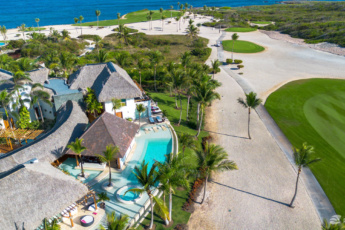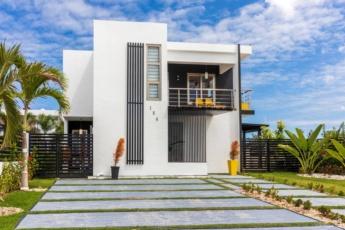Security Concerns in Private Communities: Gated vs. Non-Gated Options in Cap Cana
Understanding Security Concerns in Private Communities

Security Concerns in Private Communities: Gated vs. Non-Gated Options in Cap Cana
In today’s world, safety and security are at the forefront of considerations when choosing a place to live. This is particularly true in private communities where residents seek not only comfort and luxury but also peace of mind. The unique environment of Cap Cana, a luxurious enclave in the Dominican Republic, offers a distinctive perspective on these issues.
1. Importance of Security in Residential Areas
Security is a critical factor for homeowners and residents in private communities. It significantly influences the decision-making process when selecting a place to live. People are increasingly prioritizing safety as a non-negotiable aspect of their living environment, impacting not only their well-being but also their property investment.
In Cap Cana, the allure of pristine beaches and upscale living is complemented by a strong emphasis on security. This ensures that residents can fully enjoy their surroundings without constant concern for their safety or that of their loved ones.
- Peace of Mind: Security provides residents with a sense of calm and assurance, knowing that their community is protected. This peace of mind is essential for a high quality of life, allowing residents to focus on enjoying their homes rather than worrying about potential threats.
- Property Value: Secure communities often see an increase in property values. Prospective buyers are willing to pay a premium for homes in areas where security measures are robust and effective.
- Community Trust: A secure environment fosters a sense of trust and camaraderie among residents. When people feel safe, they are more likely to engage with their neighbors, contributing to a strong, vibrant community.
2. Types of Security Threats
Understanding the types of security threats prevalent in private communities is essential for developing effective countermeasures. In Cap Cana, specific threats have been identified that require ongoing attention and management.
- Theft and Burglary: These remain the most common threats in residential areas. Despite being in a gated or secured community, the risk of theft persists, necessitating vigilance and proactive measures.
- Vandalism: Although often perceived as a minor issue, vandalism can undermine the sense of security and aesthetic appeal of a community.
- Unauthorized Access: In areas like Cap Cana, where exclusivity is a selling point, preventing unauthorized access is crucial. Security breaches can lead to other more severe security incidents.
Addressing these threats requires a combination of technology, manpower, and community involvement to ensure that security measures are both comprehensive and adaptive to evolving risks.
3. Security Trends in Cap Cana
Cap Cana is a prime example of a community where modern security trends are being implemented to address the unique challenges of a high-end residential area. These trends reflect broader shifts in how private communities worldwide are approaching security.

Punta Cana
Technological advancements play a significant role in Cap Cana’s security strategy. The integration of smart home devices, advanced surveillance systems, and real-time monitoring has enhanced the safety and responsiveness of security efforts. However, technology is just one aspect of a broader security strategy.
- Integrated Security Systems: Many private communities, including those in Cap Cana, are adopting integrated security systems that combine video surveillance, access control, and alarm systems into a cohesive network. This integration allows for a more streamlined and efficient security response.
- Community Involvement: Engaging residents in security efforts is becoming increasingly important. Initiatives such as neighborhood watch programs and community security apps empower residents to play an active role in maintaining safety.
- Sustainability and Security: There is a growing trend towards incorporating sustainable practices into security measures. This includes using eco-friendly materials in security infrastructure and optimizing energy use in surveillance systems.
Cap Cana’s proactive approach to security serves as a model for other private communities looking to enhance their safety measures. By staying ahead of the trends and adopting a holistic approach to security, Cap Cana ensures that its residents can enjoy the beauty and tranquility of their surroundings without compromising on safety.
Gated Communities: Security Features and Benefits
The allure of gated communities often lies in their promise of enhanced security, privacy, and exclusivity. These communities are meticulously designed to minimize potential security risks and provide a serene environment for residents.

Aerial view of Punta Cana
1. Access Control Measures
Access control is a cornerstone of security in gated communities, providing a first line of defense against unauthorized entry. These measures are designed to regulate and monitor who enters and exits the community, ensuring that only residents and approved visitors gain entry.
- Guarded Entry Points: Many gated communities employ security personnel at entry points to verify identification and manage the flow of traffic. This human element adds a personalized layer of security, as trained guards can assess situations in real-time.
- Electronic Gate Systems: Automated gates equipped with keypads, card readers, or remote control access are prevalent. These systems allow for efficient and secure entry, often complemented by resident-specific access codes or key fobs.
- Visitor Management Systems: Advanced visitor management software is increasingly utilized to pre-register guests and delivery personnel, reducing wait times and enhancing security oversight.
These access control measures collectively contribute to a robust security framework, deterring potential intruders and ensuring peace of mind for residents.
2. Surveillance Systems
The role of surveillance in gated communities cannot be overstated. Surveillance systems act as both a deterrent to criminal activities and a tool for post-incident analysis.
- CCTV Cameras: Strategically placed closed-circuit television cameras monitor common areas, entrances, and perimeters 24/7. High-definition cameras with night vision capabilities ensure comprehensive coverage, regardless of time or weather conditions.
- Motion Sensors: These devices are used to detect unusual movements, particularly in less trafficked areas. When integrated with cameras, they can trigger alerts to security personnel, allowing for swift responses.
- License Plate Recognition: Advanced surveillance systems may include technology to capture and recognize vehicle license plates, further tightening access control and monitoring of vehicular traffic.
By leveraging modern surveillance technology, gated communities can provide a higher level of security, ensuring that the residents’ safety is always a top priority.
3. Community Security Personnel
Security personnel form the backbone of a gated community’s security apparatus. These individuals are responsible for maintaining order, responding to incidents, and ensuring the overall safety of residents.
- Patrolling Guards: Regular patrols by trained security guards help to quickly identify and respond to suspicious activities. Their presence alone serves as a powerful deterrent to potential wrongdoers.
- Emergency Response Teams: In many gated communities, emergency response teams are on standby to handle urgent situations such as medical emergencies or security breaches.
- Community Liaison Officers: These officers maintain communication lines between residents and the security team, fostering a sense of community involvement and trust.
The investment in skilled security personnel underscores the commitment of gated communities to provide a secure and tranquil living environment, allowing residents to enjoy their homes without concern for their safety.
Our Best Villa Rentals in Cap Cana
Discover the ultimate in luxury and security with our exclusive villa rentals in Cap Cana. Each property is nestled within a gated community, ensuring you enjoy both opulence and peace of mind during your stay.

Villa Agapi (Caleton Estates 57) - The Most Beautiful Ocean View Villa in Cap Cana
from $2150 night Read more
Exclusive Ocean View 5-Star Cap Cana Villa for Rent - Chef, Butler, Maid & Golf Cart
from $3450 night Read more
Private Villa at Puntacana Resort & Club for Rent - Pool, Jacuzzi, BBQ, Maid, Cinema Room
from $1569 night Read more
Modern & Stylish 4-BR Family-Friendly Villa Rental in a Quiet and Gated Community in Bávaro, Punta Cana
from $199 night Read moreNon-Gated Communities: Security Challenges and Solutions
Non-gated communities in Cap Cana face unique security challenges due to their open access nature. Addressing these challenges requires innovative solutions and community involvement to ensure residents feel safe and secure.
1. Open Access Concerns
The absence of physical barriers in non-gated communities can lead to several security challenges. Without controlled access points, these neighborhoods are more susceptible to unauthorized entry, leading to increased risks of burglaries, trespassing, and vandalism. This lack of restriction can also result in a higher volume of traffic, both pedestrian and vehicular, which can complicate the monitoring of suspicious activities.
In addition to these risks, non-gated communities might experience difficulties in tracking and managing the flow of visitors. This can compromise resident privacy and make it challenging to identify potential threats quickly. The lack of a physical security presence at entry points means that non-gated communities need to rely more heavily on other forms of security measures to mitigate these risks.
2. Community-Based Security Initiatives
In response to the challenges posed by open access, many non-gated communities in Cap Cana are turning to community-based security initiatives. These initiatives foster a sense of collective responsibility among residents to look out for each other and work together to enhance neighborhood safety.
Community watch programs are an effective strategy, encouraging residents to report suspicious activities and collaborate with local law enforcement. Such programs often involve regular meetings to discuss security issues and share information about potential threats. The use of smartphone apps designed for neighborhood communication can facilitate real-time updates and alerts, enhancing the community’s ability to respond swiftly to security concerns.
Moreover, community events and social gatherings can strengthen neighborly bonds, creating a more unified front against crime. By fostering a strong community spirit, residents are more likely to be vigilant and proactive in addressing security threats.
3. Innovative Security Technologies
To effectively address security challenges, non-gated communities are increasingly adopting innovative security technologies. These technologies provide an added layer of protection and can be tailored to the specific needs of each community.
Installing smart home security systems is becoming a popular choice among residents. These systems offer features such as motion detectors, remote monitoring, and automated alerts that can notify homeowners of any unusual activity. Additionally, the integration of AI-powered cameras can enhance surveillance by providing real-time analysis and detection of potential threats.
Another emerging technology is the use of drone surveillance. Drones can be deployed to monitor large areas quickly, providing aerial views that can help identify unauthorized access points or suspicious activities. When combined with community-based initiatives, these technologies can significantly bolster the overall security of non-gated communities.
Comparison of Security Technologies in Non-Gated Communities
| Technology | Features | Benefits | Limitations |
|---|---|---|---|
| Smart Home Systems | Motion detectors, remote monitoring, automated alerts | Enhanced security, real-time alerts | Dependent on internet connectivity |
| AI-Powered Cameras | Real-time analysis, threat detection | Proactive threat management | Privacy concerns |
| Drone Surveillance | Aerial monitoring, quick deployment | Comprehensive area coverage | Regulatory restrictions |
By leveraging community involvement and cutting-edge technologies, non-gated communities in Cap Cana can create a secure living environment that rivals that of their gated counterparts. These efforts not only enhance security but also build a stronger, more connected community.
Comparing Security Effectiveness: Gated vs. Non-Gated Communities
When it comes to choosing a residential community, security remains a pivotal factor. Understanding how gated and non-gated communities measure up against each other in terms of security effectiveness can significantly influence your decision-making process.

Punta Cana
1. Cost vs. Security Trade-offs
The financial implications of security measures in both gated and non-gated communities are essential to consider. Gated communities often have higher initial costs due to the infrastructure required for controlled access, surveillance systems, and security personnel. These costs are typically factored into homeowners’ association (HOA) fees or community dues. On the other hand, non-gated communities may have lower upfront costs but might incur additional expenses for individual security enhancements such as alarm systems or private security services.
In gated communities, residents benefit from shared security costs, which can include comprehensive surveillance systems and 24/7 security personnel. However, in non-gated communities, residents often bear the cost of security individually, investing in personal security systems or neighborhood watch programs. The table below compares typical security costs associated with each type of community.
Security Cost Comparison: Gated vs. Non-Gated Communities
| Community Type | Security Feature | Average Cost | Cost Coverage |
|---|---|---|---|
| Gated | Access Control & Surveillance | $200-$500/month | Shared via HOA |
| Non-Gated | Personal Security Systems | $100-$300/month | Individual |
2. Resident Satisfaction and Peace of Mind
Security measures play a crucial role in shaping residents’ quality of life and satisfaction within a community. Gated communities often provide a heightened sense of security and exclusivity, contributing to a greater peace of mind among residents. The presence of physical barriers and security personnel can deter potential intruders, fostering a sense of safety.
Conversely, non-gated communities may offer a greater sense of openness and community engagement, which can also contribute to resident satisfaction. Although they lack physical barriers, the implementation of community-based security initiatives can effectively enhance security and reassure residents. Ultimately, personal preferences and lifestyle choices significantly influence resident satisfaction in both community types.
3. Adaptability to Emerging Threats
The ability to adapt to emerging security threats is a critical consideration in evaluating the effectiveness of gated versus non-gated communities. Gated communities often have the advantage of centralized management, allowing for quicker implementation of new security technologies or protocols in response to evolving threats. Their structured management system can facilitate rapid upgrades to security infrastructure, ensuring residents remain protected.
Non-gated communities, while potentially slower to implement new security measures due to decentralized management, can benefit from grassroots initiatives and community collaboration. Residents may collectively decide on security improvements, such as neighborhood watch programs or modern smart home security systems, enhancing their ability to respond to new challenges.
In summary, both gated and non-gated communities offer unique advantages and challenges regarding security. By weighing the cost implications, resident satisfaction, and adaptability to new threats, prospective residents can make an informed decision that aligns with their security needs.
Making an Informed Choice: Selecting the Right Community for Your Security Needs
Choosing the right community involves a delicate balance between lifestyle preferences, budget considerations, and security needs. Whether opting for a gated or non-gated community in Cap Cana, understanding these elements ensures a decision that aligns with one’s priorities for safety and comfort.
1. Assessing Personal Security Needs
When contemplating a move to Cap Cana, it is crucial to identify your personal security requirements. This involves considering factors like family size, lifestyle, and the level of security you are comfortable with. Singles or young couples might prioritize proximity to amenities and vibrant community life over stringent security measures. In contrast, families with children or elderly members may prioritize enhanced security features.
To effectively assess your security needs, consider conducting a risk assessment of your current living situation. This involves identifying potential threats and evaluating your current security measures. Understanding your tolerance for risk and the specific characteristics of the neighborhood can guide you in selecting the right community.
2. Evaluating Community Security Features
Once you have a clear understanding of your security needs, the next step is to evaluate the security features offered by prospective communities. In Cap Cana, both gated and non-gated communities offer a range of security measures. However, the degree and type of security available can differ significantly.
For a comprehensive evaluation, consider the following criteria:
- Access Control: Determine the effectiveness of access controls such as gates, guards, and visitor management systems.
- Surveillance Systems: Evaluate the presence and coverage of surveillance cameras, along with their monitoring protocols.
- Community Engagement: Assess the level of community involvement in security initiatives and the presence of neighborhood watch programs.
- Technological Integration: Look for the use of modern security technologies, such as smart home devices and mobile alerts.
- Incident Response: Consider the response time and effectiveness of security personnel or local law enforcement in case of an incident.
Comparison of Security Features in Gated vs. Non-Gated Communities
| Security Feature | Gated Communities | Non-Gated Communities |
|---|---|---|
| Access Control | Highly Controlled | Limited Control |
| Surveillance | Extensive Coverage | Partial Coverage |
| Community Engagement | Moderate to High | High |
| Technological Integration | Advanced Systems | Selective Use |
| Incident Response | Swift and Efficient | Varies |
3. Long-Term Security Planning
Security needs are not static; they evolve with time and circumstances. Therefore, it is essential to engage in long-term security planning when choosing a community in Cap Cana. This involves considering future developments in the area, potential changes in crime rates, and advancements in security technology.
Prospective residents should inquire about the community’s plans for future security enhancements. Questions to consider include: Are there plans to upgrade security systems? How does the community handle emerging threats? Is there a budget for security improvements?
By taking a proactive approach to security planning, residents can ensure that their chosen community remains a safe and desirable place to live for years to come. This foresight not only enhances personal security but also contributes to the overall value and appeal of the community.
Frequently Asked Questions
What are the main security benefits of living in a gated community in Cap Cana?
Living in a gated community in Cap Cana offers several security benefits. These typically include controlled access points, which reduce the risk of unauthorized entry, and often 24/7 security patrols. Additionally, gated communities may have surveillance systems that monitor common areas and entry points, enhancing overall safety for residents.
How do non-gated communities in Cap Cana address security concerns?
Non-gated communities in Cap Cana often employ alternative security measures to ensure resident safety. These can include neighborhood watch programs, private security patrols, and the installation of security cameras at strategic locations. Residents may also be encouraged to install personal security systems in their homes for added protection.
Is it more expensive to live in a gated community compared to a non-gated community in Cap Cana?
Generally, living in a gated community may be more expensive due to additional costs associated with maintaining security infrastructure and amenities. These costs are typically covered by community fees paid by residents. However, the perceived value of increased security and exclusive amenities often justifies the higher expense for many residents.
Can non-gated communities offer the same level of security as gated ones in Cap Cana?
While non-gated communities can implement various security measures, they may not provide the same level of control over access as gated communities. However, through effective community organization and investment in security technologies, non-gated communities can still offer a high level of safety.
What are some potential drawbacks of living in a gated community in Cap Cana?
Potential drawbacks of living in a gated community can include higher community fees and possibly more restrictive community rules. The exclusivity of gated communities might also limit interactions with the broader community, affecting social dynamics for some residents.
Are there any legal requirements for security measures in private communities in Cap Cana?
As of the latest update, specific legal requirements for security measures in private communities in Cap Cana can vary. Generally, communities are encouraged to follow local guidelines and best practices for safety and security. It’s advisable to check with local authorities or community management for the most current regulations.
How does the presence of security personnel impact crime rates in gated communities in Cap Cana?
The presence of security personnel in gated communities typically helps to deter criminal activities, contributing to lower crime rates compared to non-gated areas. Security personnel can respond quickly to incidents and provide a visible deterrent to potential intruders.
What should potential homeowners consider when choosing between gated and non-gated communities in Cap Cana?
Potential homeowners should consider factors such as the level of security they desire, the cost of living, community amenities, and personal preferences. Visiting both types of communities to assess the atmosphere, safety measures, and amenities can provide valuable insights.
Are there any recent changes in security trends for private communities in Cap Cana?
Security trends can evolve, with new technologies and practices being implemented. While there may be recent advancements, it is crucial to verify the latest information with local real estate experts or community managers, as trends may change rapidly.
Please consult local resources for the most current security trends.
